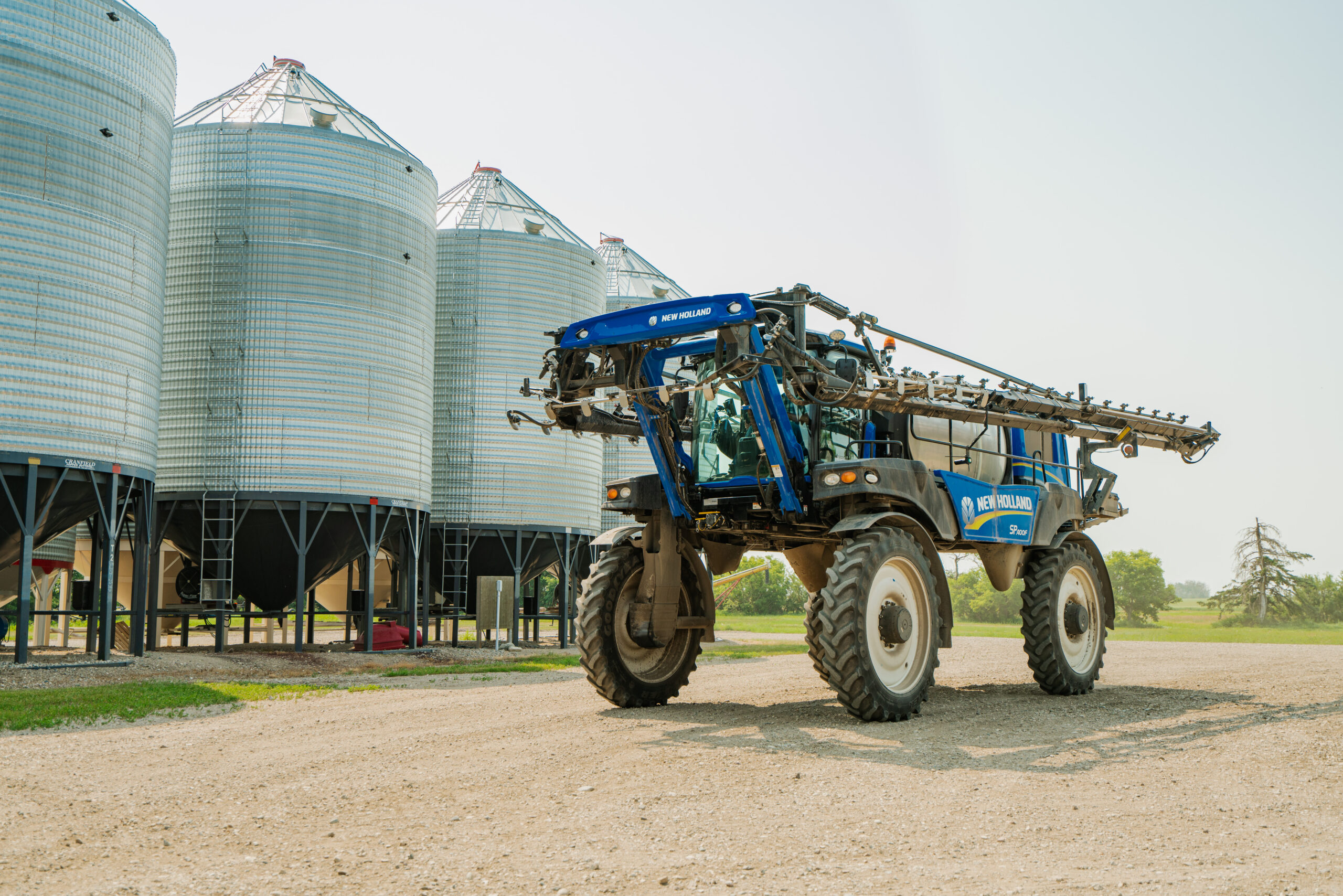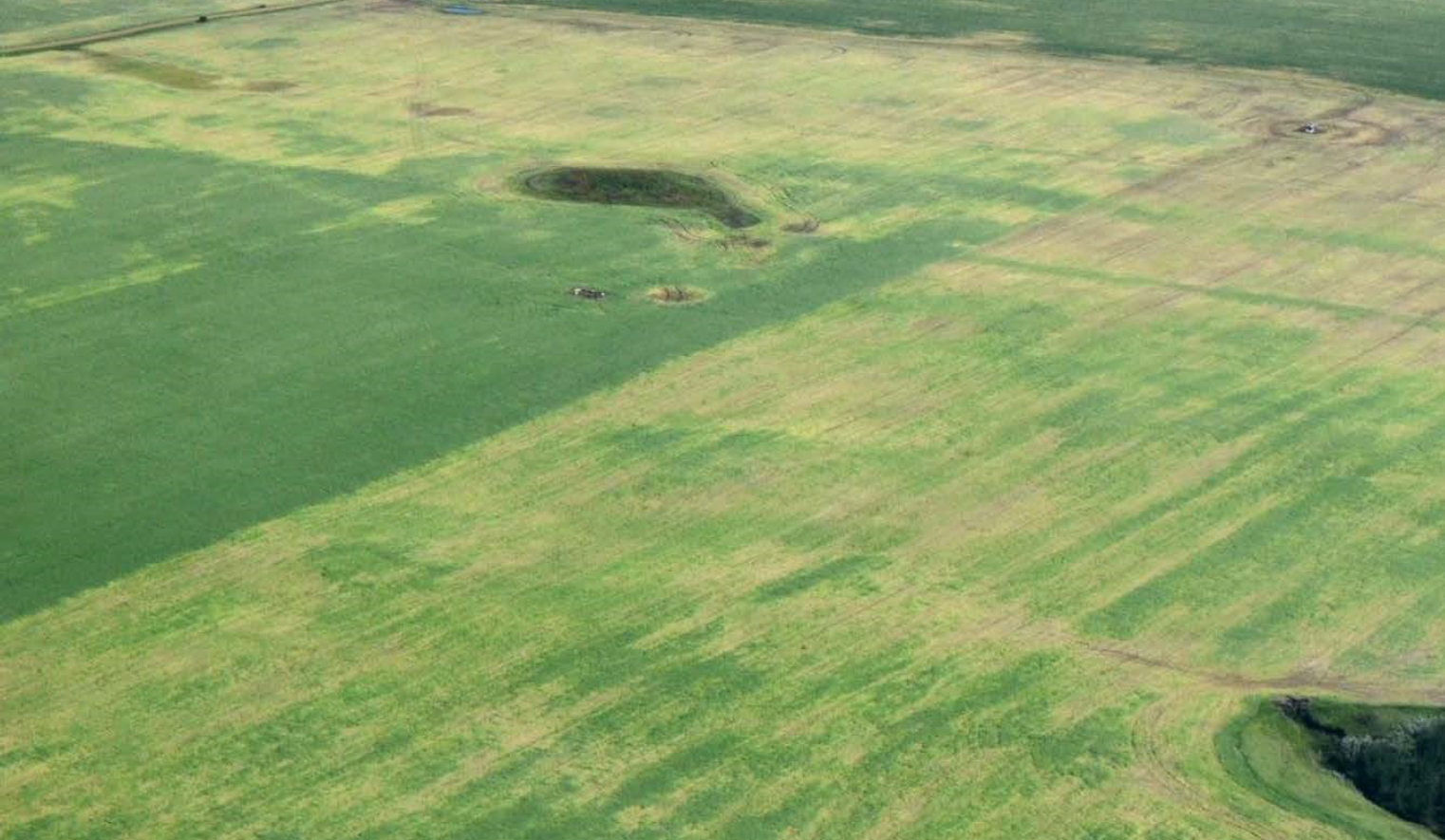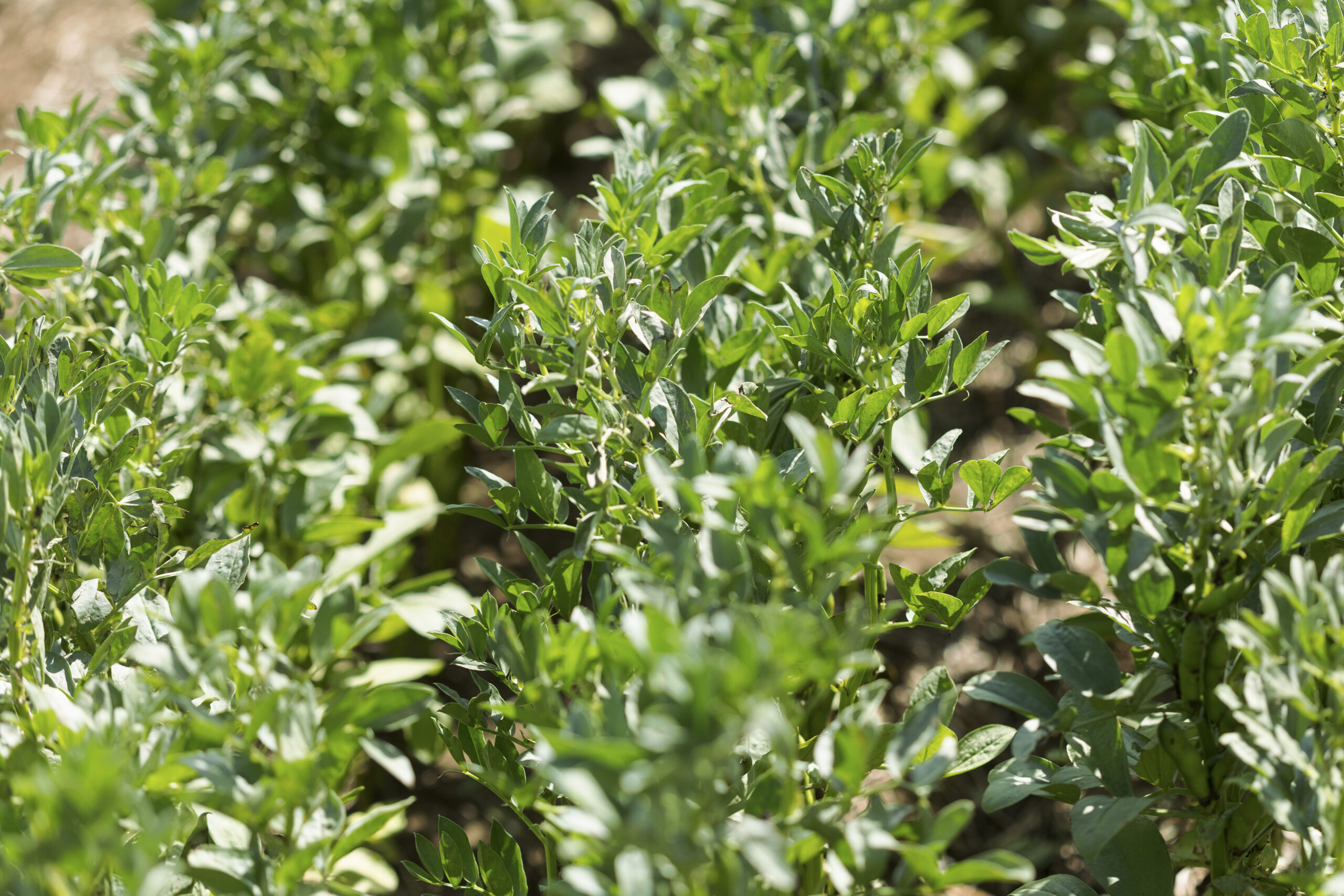By Paige Kennedy, BSA, AAg
Background
Faba beans (Vicia faba minor), also known as fava beans, are an annual legume crop that originated in Jericho thousands of years ago. Today, they are commonly grown in the Mediterranean, Europe, Australia, and Britain. Faba beans were introduced to the Canadian Prairies in 1972 and remain a small-acre crop with variable popularity, increasing in acres over the last few years in Prairie Canada. After soybean and pea, faba beans are rated globally as the third most important legume crop.
Faba beans are high in fibre, high protein, and low oil content. They can be sold for both human and animal consumption. Additionally, their notable atmospheric nitrogen-fixing ability makes them attractive when planning crop rotations: in fact, faba beans can fix 80% of their required nitrogen (N), making them the greatest N-fixer of all Prairie pulse crops. Due to their affinity for cool, wet growing conditions, faba beans can be planted early in the season which helps alleviate the springtime workload on the farm. Faba beans are tap-rooted and grow 1–1.5 m tall. They have hollow stems, compound leaves, and white or melanin (purple) flowers which produce long pods (10 cm) with 3–4 beans per pod (Fig. 1, 2).
Faba beans come in either tannin or low-tannin varieties, both of which are in high-demand in world markets. Tannin varieties have coloured (melanin) flowers and larger seeds with tan seedcoats. Low-tannin faba beans have white flowers and white seedcoats. Low-tannin varieties are grown mostly for livestock feed, while tannin varieties are preferred for human consumption.
The biggest deterrent to faba bean adoption in Saskatchewan is the presence of pyrimidine glycosides called vicine and convicine (v- c). In humans with the G6PD genetic deficiency, these compounds lead to favism, a type of anemia. When used in livestock feed, these compounds also detrimentally impact the productivity of laying hens, broiler chickens, and hogs. A low v-c faba bean variety was found in the 1980s, and breeding efforts have continued to focus on lowering v-c content ever since. Producers should take care to note the v-c content of the faba bean varieties they choose to grow as v-c can have a significant impact on marketing opportunities.
In Saskatchewan, faba beans perform best in cooler, wetter growing conditions. As a crop they have poor tolerance for salt-effected soils and are highly tolerant to Aphanomyces euteiches root rot, making faba beans an ideal crop for flood-prone areas. Faba beans thrive with early planting, due in part to their affinity for cooler temperatures, and having a longer growing season crop (105–110 days to maturity). Soil temperatures of 3–5°C at depth are sufficient for faba bean planting. Early planting also helps protect against the effects of some diseases, as the crop will be more mature at the time of high pest pressure.
Like other legume crops, faba beans are particularly susceptible to a range of foliar diseases including chocolate spot, Stemphylium blight, Ascochyta blight, and Alternaria. These diseases can pose serious challenges for producers in the Prairies and can have a detrimental impact on bean quality and yield. Often, differentiating foliar diseases is a challenge in faba beans. The following outlines the traits of each disease, how they may impact faba bean crops in the Prairies, and management practices that Saskatchewan producers can implement to help combat these diseases on their own operations.
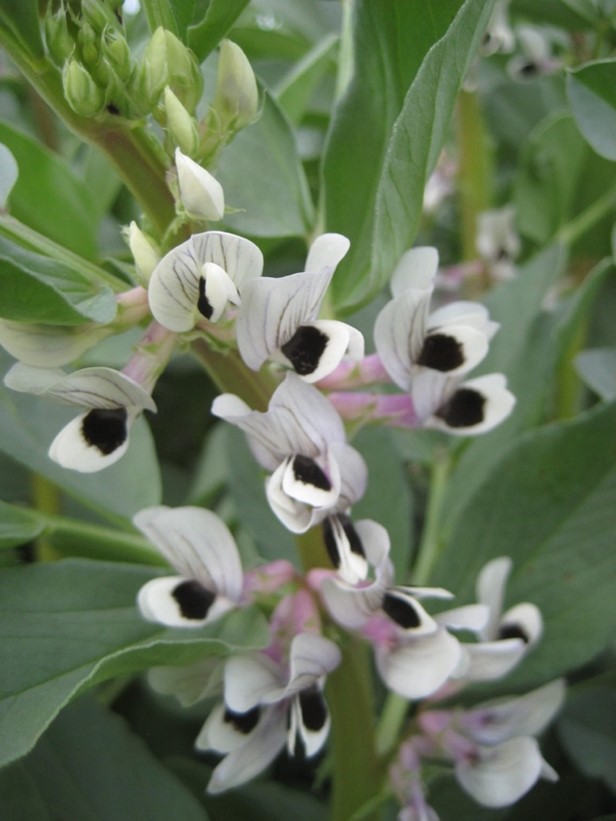
Source: Irrigated Cropping Council, AU
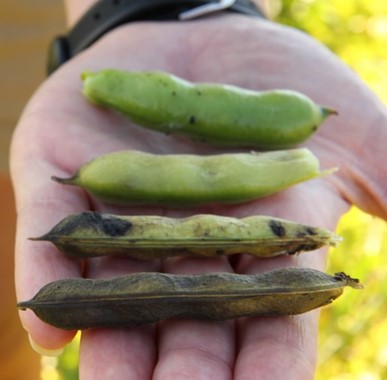
Source: RealAgriculture
Chocolate Spot
Chocolate spot is a necrotrophic fungal disease caused by Botrytis fabae and Botrytis cinerea pathogens and is the most concerning faba bean disease in Western Canada. In severe cases, chocolate spot can cause devastating effects on faba bean yields. The disease is characterized by small, round, reddish-brown lesions spread across the leaves (Figs. 3, 4). As the disease progresses, symptoms can spread to stems, pods, and flowers (Fig. 5). The small spots can grow into large grey or black necrotic sections that can severely impact plant productivity (Fig 6). Chocolate spot thrives in moist, warm growing environments and tends to spread especially quickly following rainfall events.
Chocolate spot affects faba bean crops by reducing the amount of photosynthetic plant area, thus reducing the ability of the plant to grow, thrive, and set pods. In the case of minor infection, especially later in the season, the yield-limiting effects of chocolate spot may be minimal. However, the disease can spread quickly under favourable conditions, and in severe cases, the quality and yield of the crop can be significantly and rapidly compromised (Fig. 5). In badly diseased plants, flowers and pods may be aborted and sclerotia bodies may be visible inside plant stems.
Chocolate spot is usually introduced to a field by planting infected seed. Once the disease is established in a given area, it overwinters as sclerotia in the soil or on plant debris. In the springtime, conidiophores are formed on the sclerotia, and conidia (spores) are released (Fig. 7). Spores can be transferred between plants, or between infected debris and plants via rain splash and wind. Chocolate spot infections are the most aggressive in warm, humid environments, particularly around anthesis (flowering).
Due to the seed-borne and residue-borne nature of the chocolate spot, preventative management is key. Growers should avoid planting buckwheat or lentils in crop rotations which also include faba beans because these crops act as alternate hosts for Botrytis spp. Farmers should not increase seeding rates too heavily to avoid creating an overly thick canopy as a thick plant canopy can encourage exceedingly humid environments where fungal diseases thrive.
Farmers should take care to scout their fields prior to flowering to determine the economic viability of fungicide application for chocolate spot control. If the specific planting location is known to have chocolate spot in the past, fungicides may be applied at flowering. However, depending on the environmental conditions and timing of infection, a fungicide application may not be economical since the effects of the disease are highly dependent on the infection level. According to the 2023 Saskatchewan Guide to Crop Protection, some foliar-applied fungicides registered for controlling chocolate Spot in faba beans include Priaxor® and Vertisan®. Be sure to always follow product labels for application directions.
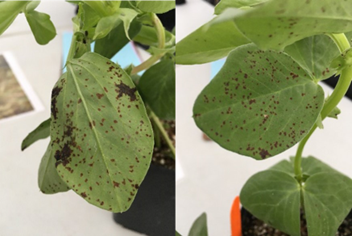
Source: Saskatchewan Pulse Growers
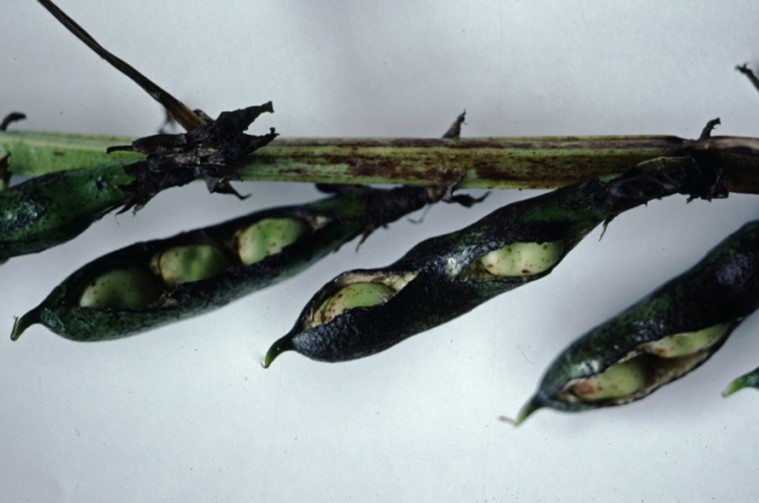
Source: Agriculture Victoria
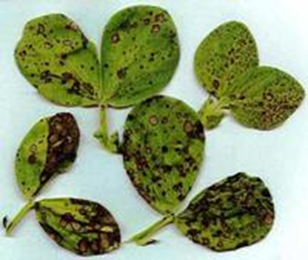
Source: Bernard Tivoli, Institut national de la recherche agronomique (INRA)
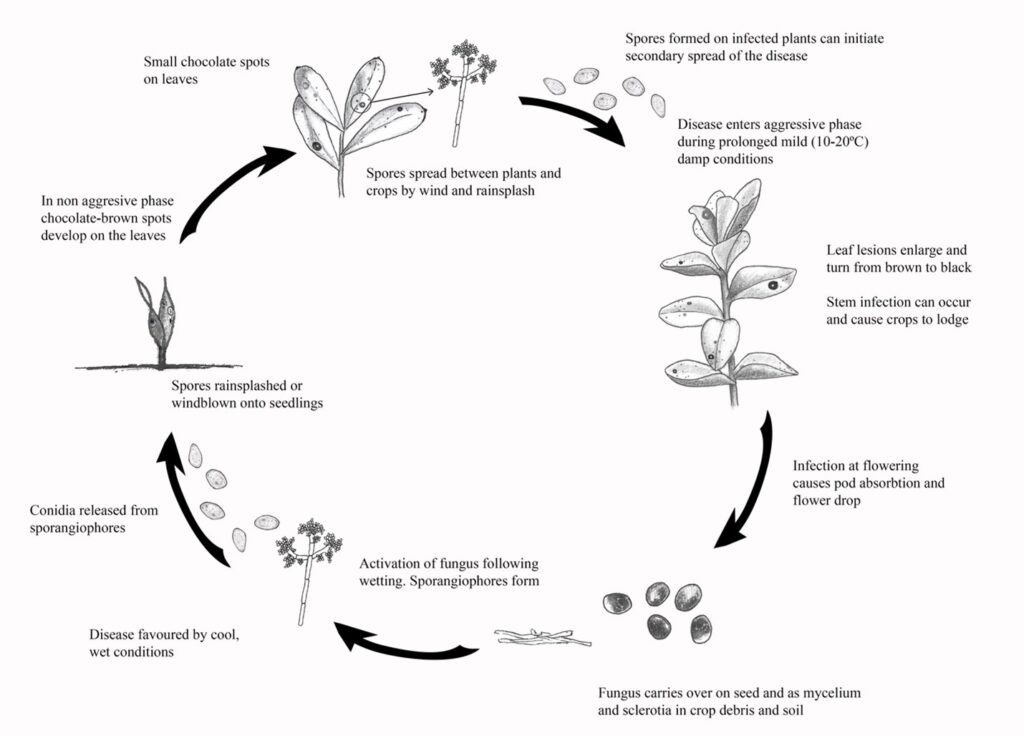
Source: Source: Kylie Fowler, Field Crop Diseases Victoria
Stemphylium Blight
Stemphylium blight in faba beans is a fungal disease caused by Stemphylium spp. It is the second most concerning faba bean disease in Western Canada following chocolate spot. Stemphylium blight is characterized by dark grey or black lesions of medium to large size on plant leaves, often originating on leaf edges (Fig. 8). The lesions eventually turn necrotic and grow in size (Fig. 9). In the early stages, Stemphylium blight may be mistaken for chocolate spot, but as it progresses symptoms differ greatly. One of the most notable differences between the diseases is the reddish lesion colour in chocolate spot, compared to the grey colour of Stemphylium blight lesions (Figs. 3, 8). Stemphylium lesions tend to start at the leaf margins, while chocolate spot lesions are peppered across the leaves. Additionally, unlike chocolate spot, Stemphylium blight symptoms are restricted to plant leaves and sometimes spread to stems. Stemphylium blight symptoms have not been known to spread to flowers or pods of faba beans.
Stemphylium blight is a relatively new disease in Western Canada, but it has quickly become widespread. Due in part to the common confusion with chocolate spot, the prevalence and impacts on yield of Stemphylium blight in Saskatchewan faba bean crops are still being explored. Symptoms seem to appear later in the season compared to other blights and seem to be more prevalent in growing seasons with high precipitation levels. In severely infected crops, reductions in plant photosynthetic ability due to necrosis in the leaf tissue may limit the productivity of the plant and make the crop more susceptible to pests and other diseases. While it remains unclear whether faba beans are infected by the same Stemphylium species as lentils, Stemphylium blight research in lentils suggests the disease has more impact on crop quality than quantity. This implies that crop yields may not be dramatically reduced by Stemphylium blight in faba beans, but that seed quality may be downgraded due to seed staining and seed size. Additional research on Stemphylium blight in pulse crops is on the horizon to better understand the specific Stemphylium groups and/or species that infect particular pulse crops.
In terms of disease management, Stemphylium in faba beans is a relatively new disease issue in the Prairies. Symptoms of this disease typically appear later in the growing season, so growers should maintain their scouting practices past flowering. Disease prevalence seems to be greatest in wet years and can be both seed and residue borne. Currently, no fungicides are registered to treat Stemphylium blight in faba bean in Saskatchewan. As such, preventative management is important. Spores can be windblown, so growers should consider field proximity when planning their faba rotations and avoid planting too close to last year’s faba bean fields. As usual, crop rotation of at least 4–5 years between faba bean crops is strongly recommended.
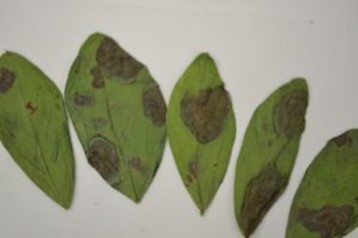
Source: Surinder Kaur
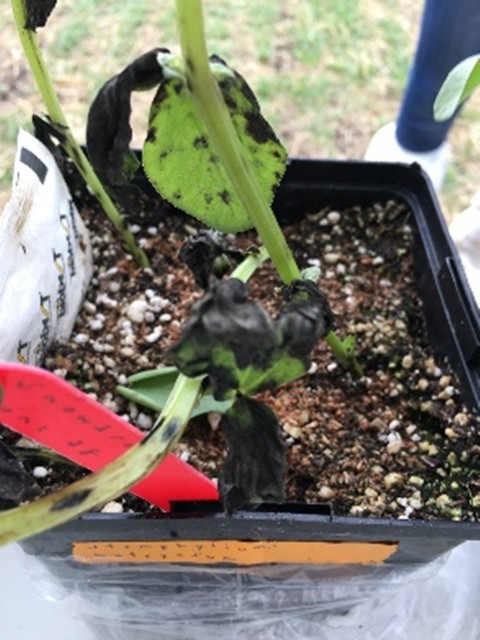
Source: Saskatchewan Pulse Growers
Ascochyta Blight
Ascochyta blight is caused by the fungal pathogen Ascochyta fabae and can be both residue and seed borne, like chocolate spot. It is considered a disease of less economic importance in Western Canada. While Ascochyta infects other legume crops, the pathogen species is crop-specific and therefore does not spread between crops. Ascochyta blight is characterized by small, dark brown spots that show on both sides of the leaves. As the disease progresses, lesions turn colour to grey or tan with dark edges and tiny black pycnidia can be seen in the lesion centers (Fig. 10). Pycnidia are asexual fruiting bodies, where fungal spores are generated and disperse from. Lesions can occur on faba bean seeds, leaves, stems, and pods. In late-stage infections, lesions can become so necrotic that the lesion center falls out and the leaves are left with holes throughout (Fig. 11). In cases of severe infections, plant stems may snap at lesion sites and cause the crop to lodge. Similar to Stemphylium blight, Ascochyta may be mistaken for chocolate spot in the early stages of infection.
Ascochyta blight thrives in cool, wet years. Producers should pay special attention to Ascochyta blight in years when July and August have high precipitation levels. Late-onset Ascochyta infection has been known to still have detrimental impacts on seed quality, so crop scouting should remain a priority into the later stages of the growing season.
In cases where Ascochyta blight infection is severe, seeds may shrivel in the pods and discolour (Fig. 12). Seed from severely infected faba bean crops may be unsellable, or heavily downgraded because of discoloration reducing profitability.
In terms of disease management, following best management practices is always encouraged. Early crop harvest, meaning early spring seeding, may help protect seed quality from late-season effects of Ascochyta blight. Cultural control methods, such as ensuring reasonable seeding rates to manage canopy density, will help to mitigate disease. If fungicides are used, they should be applied at the first sign of disease. Currently, it is not common to spray for Ascochyta blight in faba beans in Western Canada. However, according to the 2023 Saskatchewan Guide to Crop Protection, there are many foliar fungicide options registered for the control of Ascochyta blight in faba beans including Miravis® Neo 300SE, Priaxor®, Proline Gold®, and Vertisan®, among others.
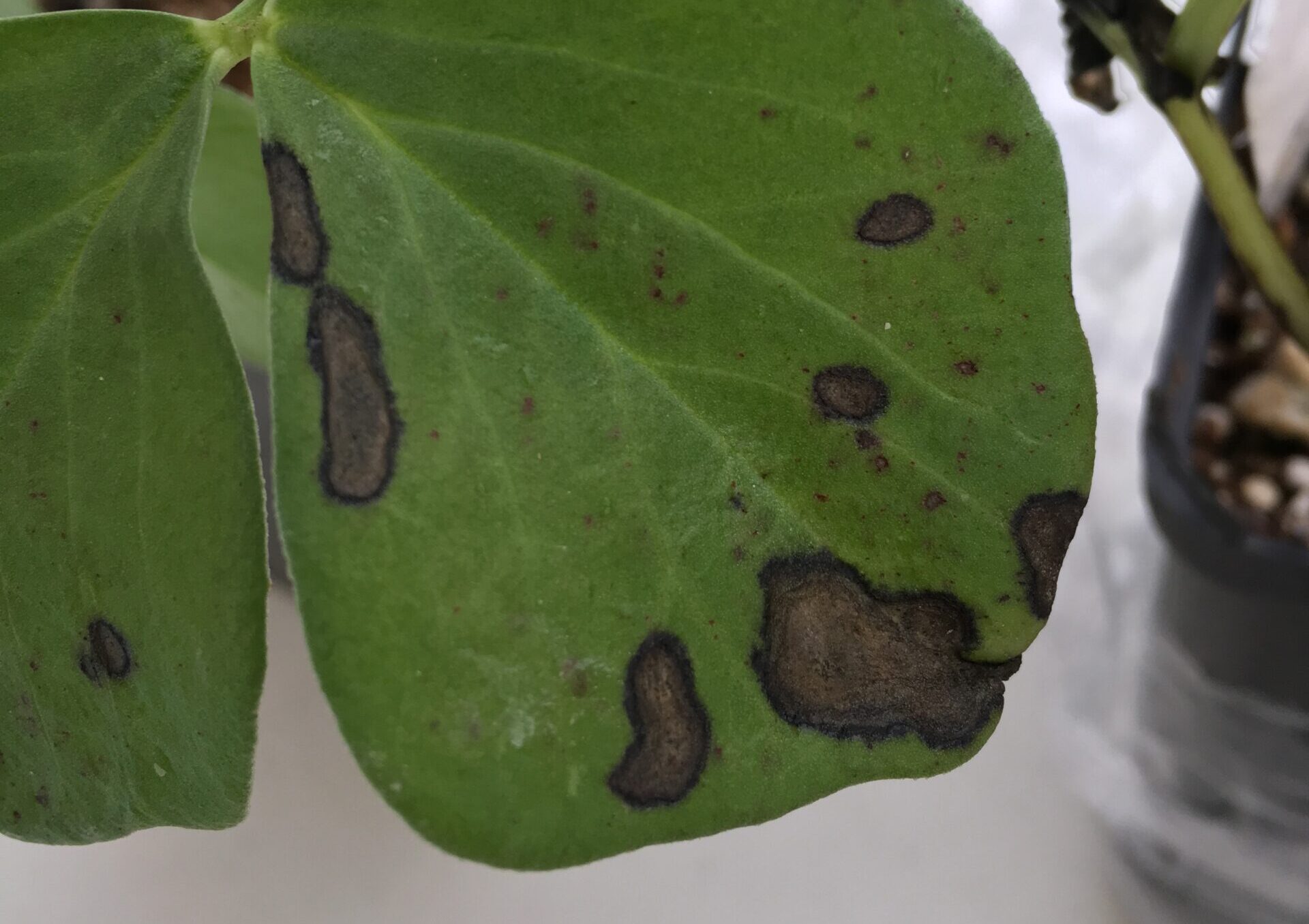
Source: Saskatchewan Pulse Growers
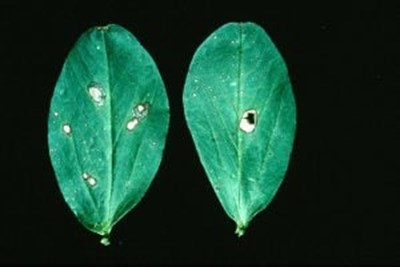
Source: Field Crop Diseases Victoria
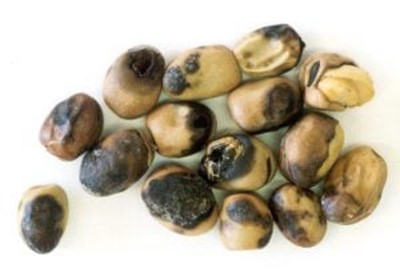
Source: Field Crop Diseases Victoria
Alternaria Leaf Spot
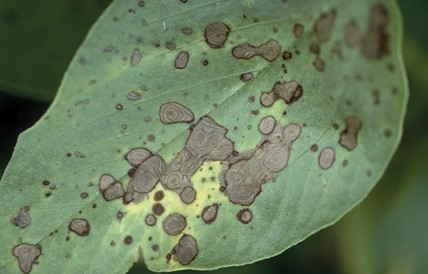
Source: Field Crop Diseases Victoria
Alternaria leaf spot, caused by the pathogen Alternaria alternata, is considered a non-yield limiting disease of minor importance for Saskatchewan faba bean growers. Like Stemphylium, Alternaria is also considered a blight disease and the two pathogens are often found together. In fact, some research refers to these leaf blotches as ‘Alternaria/Stemphylium complex’ due to the common co-existence of the pathogens.
In the early stages, Alternaria leaf spot and Ascochyta blight are often confused for each other. Alternaria can be differentiated from Ascochyta by its lack of pycnidia in lesion centers. Additionally, Alternaria leaf spot lesions have concentric rings and dark reddish margins (Fig. 13). Symptoms have been known to appear on plant leaves and pods.
When managing for Alternaria, growers need to consider non- chemical options. There are currently no fungicides registered in Saskatchewan to control Alternaria leaf spot on faba beans. Maintaining crop canopies at less-dense levels can mitigate Alternaria infections by keeping humidity low. Due to the limited economic risk associated with Alternaria leaf spot in faba beans, specific management for this disease is often not required.
General Faba Bean Disease Management
In the case of all diseases discussed, early detection is essential for successful management. Farmers should scout their fields carefully and often, starting at early leaf stage and continuing to do so at least once per week throughout the season, assuming conditions are favorable for disease. Scouts should keep an eye out for disease symptoms in the lower canopy, where they tend to appear first. Scouting should be conducted by walking fields in an “M” pattern, checking at least five spots in fields less than 100 acres, and at least ten spots in fields larger than 100 acres. Scouting should be done with the utmost of care in low-lying areas where wetter conditions encourage disease spread, and in areas where infections have been problematic in the past as there may be viable inoculum remaining in the soil or crop debris. Foliar diseases tend to thrive in seasons with heavy rainfall, so farmers should be especially alert in those years and increase their scouting frequency. Growers may refer to the faba bean scouting calendar for guidelines on scouting timing.
If disease is detected, or known to be an issue in your area, preventative and early action is highly important. Implementing a combination of chemical, cultural, and mechanical control methods can give producers a leg up on disease control in faba beans.
Chemical crop protection products should be used wisely and according to product labels. Using registered fungicidal seed treatments can be an effective way of combatting early disease in faba beans, especially if soils are cool and wet at planting time. Fungicides from groups 3, 7, and 11 (and combinations of these groups) can be used later in the season as foliar treatments for control of both chocolate spot and Ascochyta blight. Foliar fungicides should be applied at the start of flowering, or as soon as symptoms first appear. It is important to note that group 11 fungicides have a high risk of resistance development in crops, and fungicides from groups 3 and 7 are considered medium risk regarding resistance development. Farmers should refrain from spraying fungicides from the same group number consecutively to reduce the risk of developing resistant pathogens. A single fungicide application is usually sufficient to manage faba bean disease if it is applied in a timely fashion.
An effective preventative management tactic that farmers can implement is to plant the best seed available, specifically disease-free seed. Farmers should get their seed tested or purchase tested seed. If possible, growers should refrain from planting seed with infection levels greater than 10%, especially when dealing with chocolate spot. It is also important to note that fungal spores can be transported on clothing, boots, or machinery. If working in a field that is suspected to be infected, growers should ensure that their clothing and tools are sanitized prior to entering other susceptible fields.
Additionally, following a crop rotation plan of at least four years between faba bean crops is ideal when it comes to mitigating disease risk. Faba beans should not be planted right after legumes or oilseeds to reduce risk of infection with shared soil borne diseases. Planting faba bean in rotation with cereal crops is a useful strategy to reduce pest pressure since most cereal diseases tend not to infect pulses and vice versa. If planting a faba bean crop in adjacent fields, farmers should ensure that the current faba bean crop is planted at least 500 m away from the previous years’ bean stubble. This is important since many diseases can spread via spores, which can be carried considerable distances on the wind.
Residue management is another consideration to keep in mind when growing faba bean. Since many faba bean diseases can be residue borne and remain viable for a number of years, removing or burying residue in heavily infected fields may be an option for farmers to consider reducing the risk of disease spread.
Resistance breeding is a hot topic when it comes to faba bean research. When they become commercially available, selecting disease-resistant cultivars is likely to be one of the most effective management strategies that producers can incorporate. As well, it will likely become the most economical means for disease control. Currently, there are no disease-resistant faba bean cultivars available to Canadian producers. Resistance breeding in faba beans has been slower compared to other crops. As a result, the genetic composition of the crop itself, as well as relevant pests and pathogens, are largely unknown, poorly understood, or agreed upon. Promisingly, however, there have been some DNA markers developed that may help with breeding resistance to Ascochyta blight, as well as rust and broomrape (not discussed in this factsheet). Plenty of research is underway specific to chocolate spot as well, although specific DNA markers have not yet been confirmed. While progress in resistance breeding for faba beans has been relatively slow, the increasing global popularity of the crop is sure to inject more funding and interest into related research in the coming years.
If farmers require support in disease identification in their faba bean crop, they are encouraged to consult with their agronomist. Farmers may also collect diseased plant parts and document their observations in detail. Clear photographs and observations can be emailed to mreed@saskpulse.com at SPG. Plant samples may also be sent to Insight Plant Health labs in Saskatoon for analysis.
